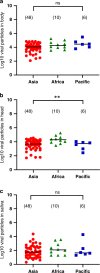Risk of yellow fever virus transmission in the Asia-Pacific region
- PMID: 33199712
- PMCID: PMC7669885
- DOI: 10.1038/s41467-020-19625-9
Risk of yellow fever virus transmission in the Asia-Pacific region
Abstract
Historically endemic to Sub-Saharan Africa and South America, yellow fever is absent from the Asia-Pacific region. Yellow fever virus (YFV) is mainly transmitted by the anthropophilic Aedes mosquitoes whose distribution encompasses a large belt of tropical and sub tropical regions. Increasing exchanges between Africa and Asia have caused imported YFV incidents in non-endemic areas, which are threatening Asia with a new viral emergence. Here, using experimental infections of field-collected mosquitoes, we show that Asian-Pacific Aedes mosquitoes are competent vectors for YFV. We observe that Aedes aegypti populations from Singapore, Taiwan, Thailand, and New Caledonia are capable of transmitting YFV 14 days after oral infections, with a number of viral particles excreted from saliva reaching up to 23,000 viral particles. These findings represent the most comprehensive assessment of vector competence and show that Ae. aegypti mosquitoes from the Asia-Pacific region are highly competent to YFV, corroborating that vector populations are seemingly not a brake to the emergence of yellow fever in the region.
Conflict of interest statement
The authors declare no competing interests.
Figures






Similar articles
-
A peridomestic Aedes malayensis population in Singapore can transmit yellow fever virus.PLoS Negl Trop Dis. 2019 Oct 7;13(10):e0007783. doi: 10.1371/journal.pntd.0007783. eCollection 2019 Oct. PLoS Negl Trop Dis. 2019. PMID: 31589616 Free PMC article.
-
Vector competence of Australian mosquitoes for yellow fever virus.Am J Trop Med Hyg. 2011 Sep;85(3):446-51. doi: 10.4269/ajtmh.2011.11-0061. Am J Trop Med Hyg. 2011. PMID: 21896802 Free PMC article.
-
Potential of Aedes albopictus and Aedes aegypti (Diptera: Culicidae) to transmit yellow fever virus in urban areas in Central Africa.Emerg Microbes Infect. 2019;8(1):1636-1641. doi: 10.1080/22221751.2019.1688097. Emerg Microbes Infect. 2019. PMID: 31711378 Free PMC article.
-
Fever versus fever: the role of host and vector susceptibility and interspecific competition in shaping the current and future distributions of the sylvatic cycles of dengue virus and yellow fever virus.Infect Genet Evol. 2013 Oct;19:292-311. doi: 10.1016/j.meegid.2013.03.008. Epub 2013 Mar 20. Infect Genet Evol. 2013. PMID: 23523817 Free PMC article. Review.
-
Yellow fever: a reemerging threat.Clin Lab Med. 2010 Mar;30(1):237-60. doi: 10.1016/j.cll.2010.01.001. Clin Lab Med. 2010. PMID: 20513550 Free PMC article. Review.
Cited by
-
Mechanisms of Yellow Fever Transmission: Gleaning the Overlooked Records of Importance and Identifying Problems, Puzzles, Serious Issues, Surprises and Research Questions.Viruses. 2024 Jan 4;16(1):84. doi: 10.3390/v16010084. Viruses. 2024. PMID: 38257784 Free PMC article. Review.
-
Evaluating vector competence for Yellow fever in the Caribbean.Nat Commun. 2024 Feb 9;15(1):1236. doi: 10.1038/s41467-024-45116-2. Nat Commun. 2024. PMID: 38336944 Free PMC article.
-
Low Transmission of Chikungunya Virus by Aedes aegypti from Vientiane Capital, Lao PDR.Pathogens. 2022 Dec 25;12(1):31. doi: 10.3390/pathogens12010031. Pathogens. 2022. PMID: 36678379 Free PMC article.
-
Mechanisms of Flavivirus Cross-Protection against Yellow Fever in a Mouse Model.Viruses. 2024 May 24;16(6):836. doi: 10.3390/v16060836. Viruses. 2024. PMID: 38932129 Free PMC article.
-
Potential role of heterologous flavivirus immunity in preventing urban transmission of yellow fever virus.Nat Commun. 2024 Nov 10;15(1):9728. doi: 10.1038/s41467-024-54146-9. Nat Commun. 2024. PMID: 39523371 Free PMC article.
References
MeSH terms
LinkOut - more resources
Full Text Sources

